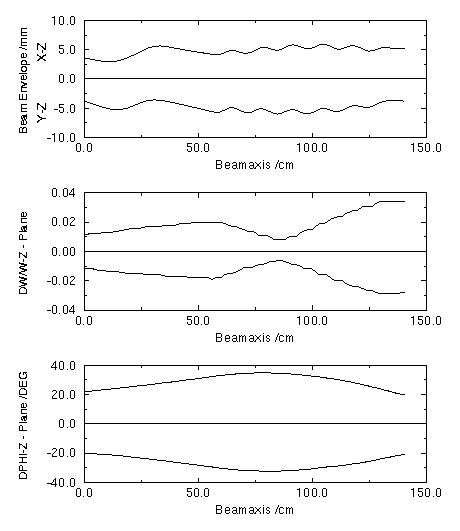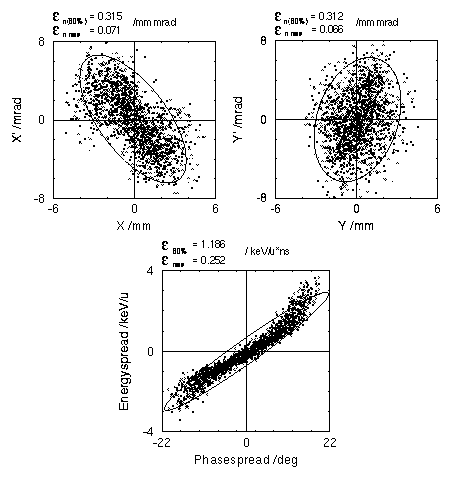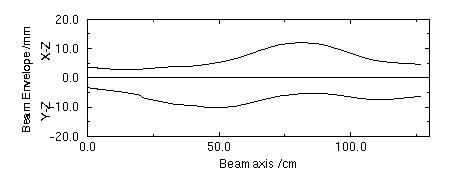The adaptation of a RFQ beam to the typical requirements at the entrance of a drift tube linac is rather difficult at high intensities and high A/q values. The high focusing power needed for such a matcher can be provided by a conventional array with rather large quadrupoles and rebuncher cavities only. Many problems arising from such a design can be avoided by using an element which is focusing in transverse and longitudinal direction at the same time, that is a short RFQ ('Super Lens') with 10 cells typically and a larger aperture as compared to the main RFQ. A xy-steerer and a short quadrupole doublet with small aperture were added to gain flexibility with regard to beam mismatch and misalignment corrections. This new concept is realised for the GSI 15 mA U4+ injector, which is under construction.
Beam dynamics calculations are presented
and compared with results for a conventional solution consisting
of a rebuncher and a quadrupole triplet.
At present a new UNILAC prestripper LINAC is under construction in order to fill the Heavy Ion Synchrotron SIS up to the space charge limit [1],[2].
The new LINAC consists of a RFQ cavity up to 120 keV/u and a IH-DTL section up to 1.4 MeV/u.
So far, for the beam matching from a RFQ into an IH-DTL the conventional array consisting of the elements quadrupole triplet (doublet) - rebuncher cavity - quadrupole doublet was used [3] [4] . These accelerators however were zero current designs with A/q values below 9.5 .
For the new GSI High Current Injector
with A/q ![]() 65 the use of similar matching
designs would lead to considerable difficulties: very powerful
and long conventional quadrupole lenses with big apertures are
necessary, as well as a powerful rebunching cavity. According
to the separation of longitudinal and transverse focusing within
such a system, it is rather sensitive with respect to beam intensity
fluctuations.
65 the use of similar matching
designs would lead to considerable difficulties: very powerful
and long conventional quadrupole lenses with big apertures are
necessary, as well as a powerful rebunching cavity. According
to the separation of longitudinal and transverse focusing within
such a system, it is rather sensitive with respect to beam intensity
fluctuations.
These problems led to the idea of using
a short adapter RFQ ('Super Lens') focusing in all three dimensions
and located directly in front of the first IH-DTL [5]. A short,
small aperture quadrupole doublet placed behind the main RFQ adds
the needed flexibility to that system.
The main parameters of the matching
section are summarized in Table 1. The geometric arrangement is
shown in Fig. 1. Between accelerator RFQ output and adapter RFQ
input a distance of about 560 mm is taken by a xy-steerer, a quadrupole
doublet, a vacuum valve and a diagnostic box. Along that distance
the beam radius is increased to around 5 mm. A 'Super Lens' minimum
aperture radius of a = 6.8 mm (compared to a = 4.1 mm at the main
RFQ output ) was chosen, which allows to get the needed emittance
shapes at the entrance of the IH-DTL. The adapter RFQ is designed
for s.p.=
-90° in order to get maximum longitudinal focusing power
and to reduce the vane-vane voltage. This leads to a rather simple
structure with 11 identical cells.
| Total Length / m | 1.4 |
| Effective Length / mm | 139 ; 115 |
| Effective Gradient / T/m | 153 ; 153 |
| Aperture Diameter / mm | 16.0 ; 16.0 |
| Cell Number | 11 |
| Electrode Length / mm | 748 |
| Frequency / MHz | 36.136 |
| Peak Vane Voltage / kV | 212 |
| Min. Aperture Radius / mm | 6.8 |
| Modulation Factor | 1.64 |
| Synchr. rf Phase / deg | - 90 |

Fig. 1 Schematic of the Matching Section
Components
For beam dynamics calculations along the IH-DTL the LORASR code has been developed during several years. It is particularly well adapted to the beam dynamics concept of 'Combined Zero Degree Synchronous Particle Sections' [6]. With the standard routines drift tube accelerating sections as well as quadrupole lens sections can be calculated. A space charge routine is included. For the new matcher, the LORASR code had to be extended in order to calculate the matcher and the IH-DTL in one step. The aim was to have an aditional tool for investigating short RFQ sections.
From a data set containing the maximum vane-vane voltage V , the longitudinally effective voltage AV/4, the cell number, the minimum aperture a and the synchronous phase for each cell, the code calculates the cell lengths and modulation factors m and simulates the RFQ fields based on the 2-term-potential description from ref. [7].
At s.p.= -90, the entrance and exit regions of the adapter RFQ are very sensitive with respect to fringe field disturbances, because the electrodes are on maximum potential at bunch passage. For that reason fringe field calculations are included, based on the analytical potential expansion as proposed in ref. [8] . Unfortunately it was not very well suited in the present case with matching in and out sections relatively short compared to the cell lengths and high modulation factors, so careful fitting of boundary conditions was necessary. To get rid of the disturbing higher order potential expansion modes along the real geometric distance from electrode end to the resonator end wall, the calculated space was extended by 80% beyond the end wall. This led to a remaining potential on the end wall of 5 % of the max. electrode potential, the equipotential surface fitting rather well to the end wall geometry.
The main result on fringe field calculations
was that beam quality deteriorations are kept small if the matching
in and out region is short. Therefore it was decided to have a
distance of 7 mm only between electrode ends and end walls.
Calculations were performed with 4 different beam intensities of 0, 5, 10 and 16.5 emA respectively and with corresponding input particle distributions as derived from the main RFQ calculations. A optimum parameter set for each intensity was defined [9]. Additionally, the sensitivity of a given parameter set with respect to beam intensity changes was investigated.
In routine operation, the new LINAC will have to assure good beam quality at the full range of intensities and should be independent of beam intensity fluctuations.
Fig. 2 and 3 illustrate the calculation results for the entire matching section at 16.5 emA. The main characteristics are : the transverse beam envelope is rather smooth ; the longitudinal focusing into the IH-DTL is done in a controlled way and is stable against moderate shifts of rf operation parameters at the RFQ and at the 'Super Lens'. The complete array is also resistant to the different beam parameter requirements described above.
Emittance growth is essentially due
to space charge effects, because at low beam current values it
is negligible.

Fig. 2. Transverse and longitudinal
100 % beam envelopes.

Fig. 3. Matcher Output Emittance Plots
( 16.5mA ; A/q=65 ).
In early design studies the possibility
of using a conventional matching section was checked. The beam
dynamics calculations result for a 16.5 emA beam with
A/q = 65 is shown in Fig. 4 and 5. The corresponding parameters
of the components are summarised in Table 2.
| Total Length / m | 1.3 |
| Effective Length / mm | 230 ; 320 ; 190 |
| Effective Gradient / T/m | 65 ; 63 ; 65 |
| Aperture Diameter / mm | 36 ; 36 ; 36 |
| Gap Number | 2 |
| Total Length / mm | 200 |
| Peak Gap Voltage / kV | 240 |
As the design presented in Fig. 4 has some disadvantages which will be mentioned below, it was decided early not to investigate this alternative further on, so that detailed calculations for different beam currents are missing. However from the experience with the 16.5 emA optimisation the design is expected to be much more sensitive to beam current and rf level variation.
From Fig. 4 it can be seen that before transverse focusing first becomes evident, a big beam radius of around 10 mm in one space is already reached, which makes refocusing by a long and powerfull quadrupole triplet necessary. Placing the triplet in front of the rebuncher would have made the beam focusing into the IH-DTL even more complicated.
On the other hand, placing the rebuncher in front makes the longitudinal focusing difficult and sensitive to beam intensity fluctuations (Fig.5). One can see that a compact beam with small phase extension cannot be properly focused into the DTL. In fact it had to be enlarged in phase space at the main RFQ output, which needed additional matching out gymnastics at the main RFQ.
The emittance growth values for the
investigated case were comparable to those of the new matcher.


Fig. 5. Longitudinal 100 % beam envelopes
for the rebuncher cavity - quadrupole triplet configuration.
Many thanks to all members of IAP -
Universty Frankfurt engaged in this project - especially to A.
Schempp - for the close collaboration in finding out the optimum
beam parameters at the matcher input, and to J.Klabunde for the
discussions on this subject.
[1] "Beam Intensity Upgade of the GSI Accelerator Facility", GSI-95-05 Report.
[2] U.Ratzinger, "The New GSI Injector Linac for High Current Heavy Ion Beams", these Proceedings.
[3] J.Klabunde, "The High Charge State Injector for GSI", Proc. of the 1992 Linac Conf. Ottawa, AECL-10728,Vol.1,p.570-574.
[4] H.Haseroth, "The CERN Heavy Ion Facility", Proc. of the 1994 EPAC, London, p.138-142.
[5] U.Ratzinger, "High Current IH Structures", Proc. of the 1994 EPAC, London, p.264-266.
[6] U.Ratzinger, "The IH Structure and its Capability to Accelerate High Current Beams", Conf. Record of the 1991 IEEE PAC, San Francisco, 91 CH 3038-7, p.567.
[7] I.M.Kapchinsky, "Theory of Resonance Linear Accelerators", Harwood Academic Publishers, New York 1985, Sect. 2.10.
[8] K.R.Crandall, "RFQ Radial Matching Sections and Fringe Fields", Proc. of the 1984 Linac Conf. Darmstadt, GSI-84-11, p.109-111.
[9] A.Schempp, "Design of Compact RFQ's", these Proceedings.